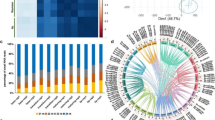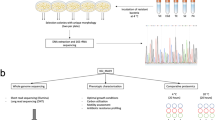Abstract
Cold temperature is an important environmental factor that affects the lives of many organisms in various ways. In this study, cold temperature was found to promote the release of zoospores from Phytophthora sojae sporangia. To better understand this phenomenon, Illumina sequencing was used to examine the differential expression of P. sojae genes between three control libraries and three cold temperature (4°C) treatment libraries. The six libraries generated 1.04, 1.17, 1.11, 0.96, 1.23, and 1.13 million clean sequencing reads. Comparison of the gene expression levels between the control and cold treatment conditions revealed 175 differentially expressed genes (DEGs), including 38 up-regulated and 137 down-regulated genes in the cold temperature group compared to the control group. The DEGs were functionally classified using the Clusters of Orthologous Groups (COG) database, and the results indicated that these DEGs were mainly involved in signal transduction, translation, ribosomal structure and biogenesis, transcription and carbohydrate transport and metabolism. KEGG pathway analysis showed that the top 20 pathways significantly enriched in DEGs included amino sugar and nucleotide sugar metabolism, arginine and proline metabolism, and starch and sucrose metabolism. Some of the DEGs are involved in the release of zoospores from P. sojae sporangia is discussed in the present work. This information will be helpful for understanding the mechanism of zoospore release induced by cold temperature.
Similar content being viewed by others

Change history
15 April 2019
The name of the first author should read <Emphasis Type="Italic">Y. H. Wang</Emphasis>.
References
Kaufmann, M.J. and Gerdemann, J.W., Root and stem rot of soybean caused by Phytophthora sojae sp., Phytopathology, 1958, vol. 48, no. 4, pp. 201–208.
Schmitthenner, A.F., Problems and progress in control of Phytophthora root rot of soybean, Plant Dis., 1985, vol. 69, no. 4, pp. 362–368.
Jee, H., Occurrence of Phytophthora root on soybean (Glycine max) and identification of the causal fungus, J. Crop Protect., 1998, vol. 40, no. 1, pp. 16–22.
Huang, J., Guo, N., Li, Y.H., et al., Phenotypic evaluation and genetic dissection of resistance to Phytophthora sojae in the Chinese soybean mini core collection, BMC Genet., 2016, vol. 17, no. 1, pp. 1–14.
Shen, C.Y. and Su, Y.C., Discovery and preliminary studies of Phytophthora megasperma on soybean in China, Acta Phytopathol. Sin.,1991, vol. 4, p. 298.
Wen, J.Z. and Zhang, M.H., The pathogen causing Phytophthora disease of soybean, Chin. J. Oil Crop Sci., 1998, vol. 4, pp. 40–45.
Xu, X.H., Qu, J.J., and Zhang, X.P., Progress of research on Phytophthora root rot, J. Northeast Agric. Univ., 2003, vol. 34, no. 4, pp. 474–477.
Dai, Y., Liu, T.F., Zhang, L.F., et al., First report of Phytophthora root and stem caused by Phytophthora sojae on soybean in Taihe, China, Plant Dis., 2015, vol. 99, no. 12, p. 1861.
Morris, P.F. and Ward, E.W.B., Chemoattraction of zoospores of the soybean pathogen, Phytophthora sojae, by isoflavones, Physiol. Mol. Plant Pathol., 1992, vol. 40, no. 1, pp. 17–22.
Judelson, H.S. and Tani, S., Transgene-induced silencing of the zoosporogenesis-specific NIFC gene cluster of Phytophthora infestans involves chromatin alterations, Eukaryot Cell, 2007, vol. 6, no. 7, pp. 1200–1209.
Dorrance, A.E., Mills, D., Robertson, A.E., et al., Phytophthora root and stem rot of soybean, Plant Health Instr., 2007, pp. 1–10.
Hardham, A.R., Cell biology of plant–oomycete interactions, Cell Microbiol., 2007, vol. 9, no. 1, pp. 31–39.
Tyler, B.M., Phytophthora sojae: root rot pathogen of soybean and model oomycete, Mol. Plant Pathol., 2007, vol. 8, no. 1, pp.1–8.
Zhang, M., Lu, J., and Tao, K., A Myb transcription factor of Phytophthora sojae, regulated by MAP kinase PsSAK1, is required for zoospores development, PLoS One, 2012, vol. 7, no. 6, p. 40246.
Ribeiro, O.K., Physiology of asexual sporulation and spore germination in Phytophthora, Plant Pathog. Fungi, 1983, pp. 55–70.
Tani, S. and Judelson, H., Activation of zoosporogenesis-specific genes in Phytophthora infestans involves a 7-nucleotide promoter motif and cold-induced membrane rigidity, Eukaryot Cell, 2006, vol. 5, no. 4, pp. 745–752.
Lan, C.Z., Chen, Q.H., Zhao, J., et al., Studies on the methods for stimulating large a mounts of sporangia of Phytophthora sojae, Acta Agric. Univ. Jiangxiensis, 2007, vol. 29, no. 4, pp. 557–560.
Zuo, Y.H., Jian, Z.J., and Liu, X.R., Studies on production condition of zoospores of Phytophthora sojae, Acta Phytopathol. Sin., 2001, vol. 31, no. 3, pp. 241–245.
Belova, I.V., Tochilina, A.G., Solovyeva, I.V., et al., Lactobacillus fermentum 90 TC-4 taxonomic status confirmation using whole genome sequencing and MALDI TOF mas spectrum, Russ. J. Genet., 2016, vol. 52, no. 9, pp. 907–913.
Omelchenko, D.O., Rzhaninova, A.A., Goldshtein, D.V., et al., Comparative transcriptome pairwise analysis of spontaneously transformed multipotent stromal cells from human adipose tissue, Russ. J. Genet., 2014, vol. 50, no. 1, pp. 96–104.
Yu, Y., Huang, W.G., Chen, H.Y., et al., Identification of differentially expressed genes in flax (Linum usitatissimum L.) under saline-alkaline stress by digital gene expression, Gene, 2014, vol. 549, no. 1, pp. 113–122.
Qin, Y.F., Fang, H.M., Tian, Q.N., et al., Transcriptome profiling and digital gene expression by deepsequencing in normal/regenerative tissues of planarian Dugesia japonica, Genomics, 2011, vol. 97, no. 6, pp. 364–371.
Yan, H., Zhang, H., Chen, M., et al., Transcriptome and gene expression analysis during flower blooming in Rosa chinensis ‘Pallida,’ Gene, 2014, vol. 504, no. 1, pp. 96–103.
Kim, D., Pertea, G., Trapnell, C., et al., TopHat2: accurate alignment of transcriptomes in the presence of insertions, deletions and gene fusions, Genome Biol., 2013, vol. 14, no. 4, pp. 295–311.
Judelson, H.S. and Blanco, F.A., The spores of Phytophthora: weapons of the plant destroyer, Nat. Rev. Microbio, 2005, vol. 3, no. 1, pp. 47–58.
Tani, S., Yatzkan, E., and Judelson, H.S., Multiple pathways regulate the induction of genes during zoosporogenesis in Phytophthora infestans, Mol. Plant–Microbe Interact., 2004, vol. 17, no. 3, pp. 330–337.
Judelson, H.S. and Roberts, S., Novel protein kinase induced during sporangial cleavage in the oomycete Phytophthora infestans, Eukaryot. Cell, 2002, vol. 1, no. 5, pp. 687–695.
Chinnusamy, V., Zhu, J.H., and Zhu, J.K., Cold stress regulation of gene expression in plants, Trends Plant Sci., 2007, vol. 12, no. 10, pp. 444–451.
Wang, J.M., Yang, Y., Liu, X.H., et al., Transcriptome profiling of the cold response and signaling pathways in Lilium lancifolium, BMC Genomics, 2014, vol. 15, no. 1, pp. 1–20.
Suzuki, N. and Mittler, R., Reactive oxygen species and temperature stresses: a delicate balance between signaling and destruction, Physiol. Plant., 2006, vol. 126, no. 1, pp. 45–51.
Barrett, K.E., Barman, S.M., Boitano, S., et al., Overview of cellular physiology in medical physiology, in Ganong’s Review of Medical Physiology, Barrett, K.E., Barman, S.M., Boitano, S., and Brooks, H., Eds., 2011.
Campos, P.S., Quartin, V., Ramalho, J.C., et al., Electrolyte leakage and lipid degradation account for cold sensitivity in leaves of Coffea sp. plants, J. Plant Physiol., 2003, vol. 160, no. 3, pp. 283–292.
Liu, Y.B., Liu, M.L., Li, X.R., et al., Identification of differentially expressed genes in leaf of Reaumuria soongorica under PEG-induced drought stress by digital gene expression profilin, PLoS One, 2013, vol. 9, no. 4. e94277
Fulda, S., Gorman, A.M., Hori, O., et al., Cellular stress responses: cell survival and cell death, Int. J. Cell Biol., 2010.
Kolesnikov, Y.S., Nokhrina, K.P., Kretynin, S.V., et al., Molecular structure of phospholipase D and regulatory mechanisms of its activity in plant and animal cells, Biochemistry, 2012, vol. 77, no. 1, pp. 1–14.
Lee, S., Hirt, H., and Lee, Y., Phosphatidic acid activates a wound-activated MAPK in Glycine max, Plant J. Cell Mol. Biol., 2001, vol. 26, no. 5, pp. 479–486.
Sang, Y., Cui, D., and Wang, X., Phospholipase D and phosphatidicacid-mediated generation of superoxide in Arabidopsis, Plant Physiol., 2001, vol. 126, no. 4, pp. 1449–1458.
Yamaguchi, T., Minami, E., Shibuya, N., Activation of phospholipases by N-acetylchitooligosaccharide elicitor in suspension-cultured rice cells mediates reactive oxygen generation, Physiol. Plant., 2003, vol. 118, no. 3, pp. 361–370.
Bocckino, S., Blackmore, P., Wilson, P., et al., Phosphatidate accumulation in hormone-treated hepatocytes via a phospholipase D mechanism, J. Biol. Chem., 1987, vol. 118, no. 3, pp. 15309–15315
Hodgkin, M., Pettitt, T., Martin, A., et al., Diacylglycerols and phosphatidates: which molecular species are intracellular messengers?, Trends Biochem. Sci., 1998, vol. 23, no. 6, pp. 200–204.
Author information
Authors and Affiliations
Corresponding author
Additional information
The article is published in the original.
Rights and permissions
About this article
Cite this article
Wang, Y., Jin, X., Rui, H. et al. Cold Temperature Regulation of Zoospore Release in Phytophthora sojae: The Genes That Differentially Expressed by Cold Temperature. Russ J Genet 54, 618–628 (2018). https://doi.org/10.1134/S1022795418060133
Received:
Accepted:
Published:
Issue Date:
DOI: https://doi.org/10.1134/S1022795418060133



